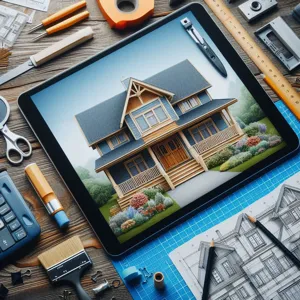When it comes to enhancing the curb appeal and overall durability of your home, the choice of siding is a crucial decision that can make a significant impact.
With a multitude of options available, from classic wood to modern vinyl and innovative fiber cement, selecting the right siding can feel overwhelming. Not only does your choice affect the aesthetic appeal of your home, but it also plays a vital role in insulation, weather resistance, and maintenance requirements. In this comprehensive guide, we will delve into the various types of siding materials, exploring their unique features, benefits, and potential drawbacks. Additionally, we’ll provide essential maintenance tips to help you protect your investment and keep your home looking its best for years to come. Whether you’re building a new home or considering a renovation, this guide will empower you to make informed decisions that align with your style, budget, and long-term goals. Let’s embark on this journey to discover the perfect siding solution for your home!
1. Introduction to Siding: Why It Matters

When it comes to enhancing the curb appeal and overall functionality of your home, siding plays a pivotal role that often goes underestimated. As the first line of defense against the elements, the right siding not only protects your home from rain, wind, and snow but also contributes significantly to its energy efficiency, insulation, and structural integrity. In fact, siding serves as a barrier that can keep your home comfortable year-round while also safeguarding it from potential damage that could lead to costly repairs down the line.
Moreover, siding is a key component of your home’s aesthetic. With a myriad of materials, colors, and styles available, the siding you choose can dramatically influence your home’s character, conveying everything from traditional warmth to modern sophistication. Whether you’re aiming for a cozy cottage look or a sleek, contemporary façade, the right siding can create an inviting first impression for visitors and potential buyers alike.
Additionally, siding maintenance is crucial for ensuring that your home remains in tip-top shape. Regular upkeep not only prolongs the lifespan of your siding but also preserves its appearance and functionality. From routine cleaning to timely repairs, understanding how to care for your chosen siding type can help you avoid premature wear and tear, ultimately saving you money and hassle in the long run.
In this comprehensive guide, we will delve into the various types of siding available, their unique benefits, and essential maintenance tips to help you make an informed decision for your home. Whether you’re building from scratch, undertaking a renovation, or simply looking to refresh your exterior, this guide will equip you with the knowledge you need to choose the right siding and keep it looking great for years to come.
2. Key Factors to Consider When Choosing Siding
When it comes to selecting the right siding for your home, several key factors come into play that can significantly impact both aesthetics and functionality. Understanding these considerations can help you make an informed choice that enhances your property’s curb appeal while providing long-lasting protection.
**1. Climate and Weather Resistance:** The geographic location of your home plays a crucial role in siding selection. For instance, if you live in an area prone to extreme weather—such as heavy rains, snow, or high winds—you’ll want siding materials that can withstand these elements. Fiber cement siding is known for its exceptional durability and resistance to moisture, while vinyl siding offers flexibility in colder climates to prevent cracking. Assessing your local climate is essential to choose siding that can endure the environmental conditions.
**2. Aesthetic Appeal:** Your home’s exterior reflects your personal style, so consider the visual aspect of the siding. Siding comes in various materials, colors, and textures, from the classic charm of wood to the sleek modernity of metal. Think about how the siding will complement your existing architecture and landscape. Samples and swatches can help visualize how different colors and finishes will look on your home, ensuring that your choice aligns with your vision.
**3. Maintenance Requirements:** Different siding materials come with varying levels of upkeep. For example, wood siding offers a warm aesthetic but requires regular painting or staining to protect it from rot and insect damage. Conversely, vinyl siding is relatively low-maintenance, needing only occasional cleaning with soap and water. Carefully consider how much time and effort you are willing to invest in maintenance, as this will influence your long-term satisfaction with the siding.
**4. Budget Considerations:** Finally, your budget will significantly influence your decision. Siding materials can vary widely in cost, not just for the initial installation but also for maintenance and longevity. While options like vinyl or fiber cement may have a higher upfront cost, they can save you money in the long run due to their durability and lower maintenance needs. It’s advisable to balance quality with your budget, ensuring you choose a siding that provides value without compromising your financial plans.
By carefully evaluating these key factors—climate suitability, aesthetic preferences, maintenance requirements, and budget constraints—you can confidently select siding that enhances your home’s beauty and performance for years to come.
3. Overview of Siding Materials: An Introduction

When it comes to enhancing the aesthetic appeal and durability of your home, the choice of siding materials plays a pivotal role. With a multitude of options available, each boasting its own unique characteristics, understanding the different types of siding is essential for making an informed decision. In this section, we will provide a comprehensive overview of popular siding materials, highlighting their benefits, drawbacks, and maintenance requirements.
**Vinyl Siding**: One of the most prevalent choices among homeowners, vinyl siding is celebrated for its affordability and low maintenance. Available in a wide array of colors and styles, it can mimic the appearance of traditional wood siding without the associated upkeep. However, while it resists rot and insects, it can be prone to fading and cracking over time, particularly in extreme weather conditions.
**Wood Siding**: Offering timeless beauty, wood siding brings warmth and character to any home. Available in various styles (such as clapboard, shingles, or board-and-batten), it provides versatility in design. That said, wood siding requires regular maintenance, including painting or staining, to protect it from moisture, pests, and decay. Without proper care, it can become susceptible to warping and splitting.
**Fiber Cement Siding**: A robust option that combines the best of both worlds, fiber cement siding is composed of a mixture of cement, sand, and cellulose fibers. It offers the appearance of wood with enhanced durability and resistance to fire, insects, and rot. Though it requires periodic painting, the finish lasts longer compared to wood. It’s also heavier and may require professional installation, making it a more significant investment upfront.
**Aluminum Siding**: Lightweight and easy to install, aluminum siding is another low-maintenance option that resists rust and corrosion. It can be painted in various colors and finishes, providing flexibility in design. However, it is susceptible to dents and scratches, and its insulation properties are not as effective as other materials.
**Stucco**: A popular choice in warmer climates, stucco is a cement-based siding that offers a unique texture and aesthetic appeal. It is highly durable and can last for decades with proper maintenance, though it may require occasional resealing to prevent moisture intrusion. Its application is labor-intensive, often necessitating skilled professionals for installation.
As you explore these siding options, consider factors such as climate, budget, and the overall style of your home. Each material has its own maintenance requirements and longevity, making it crucial to assess your long-term needs alongside your immediate preferences. In the following sections, we will delve deeper into the maintenance tips specific to each siding type, ensuring your investment remains beautiful and functional for years to come.
4. Vinyl Siding: Pros, Cons, and Maintenance Tips
Vinyl siding has become one of the most popular choices for homeowners looking to enhance their property’s exterior, and for good reason. This versatile material offers an impressive combination of durability, affordability, and aesthetic appeal that can suit a variety of home styles. However, like any siding option, it comes with its own set of advantages and disadvantages that you’ll want to consider before making a decision.
### Pros of Vinyl Siding
One of the standout benefits of vinyl siding is its low maintenance requirements. Unlike wood siding, which needs regular painting, staining, and sealing, vinyl siding is virtually maintenance-free. A simple wash with soap and water is usually all it takes to keep it looking fresh and vibrant. Additionally, vinyl siding is resistant to rot, insects, and fading, making it a durable option for homeowners in various climates.
Another significant advantage is its cost-effectiveness. Vinyl siding typically comes at a lower price point compared to other materials like wood or fiber cement. This affordability extends not only to the installation costs but also to the long-term savings on maintenance and replacement expenses, making it an attractive choice for budget-conscious homeowners.
### Cons of Vinyl Siding
However, vinyl siding is not without its drawbacks. One of the primary concerns is its susceptibility to extreme weather conditions. In areas prone to heavy winds or hail, vinyl siding can crack or become damaged, leading to costly repairs. Additionally, while vinyl is available in a multitude of colors and styles, the color choices are somewhat limited compared to other materials, and darker colors can absorb heat, leading to warping or distortion over time.
Another consideration is the environmental impact of vinyl. Made from PVC (polyvinyl chloride), the production and disposal of vinyl siding raise concerns regarding sustainability. If eco-friendliness is a priority for you, it may be worth exploring alternative siding options.
### Maintenance Tips for Vinyl Siding
To ensure your vinyl siding stands the test of time, regular maintenance is key. Here are some essential tips to keep your siding in top condition:
1. **Routine Cleaning**: Aim to clean your vinyl siding at least once a year. Use a mixture of mild soap and water, and scrub with a soft brush or cloth to remove dirt, mildew, and stains. For tougher spots, a specialized vinyl siding cleaner can be effective.
2. **Inspect for Damage**: Regularly check your siding for any signs of damage, such as cracks or loose panels. Addressing these issues promptly can prevent further complications and maintain the integrity of your home’s exterior.
3. **Trim Vegetation**: Ensure that shrubs and trees are trimmed back from your siding. Overgrown plants can trap moisture against the surface, leading to mold growth and potential damage.
4. **Keep an Eye on Gutters**: Clean your gutters regularly to prevent overflow and water damage, which can affect the siding. Proper drainage is crucial to maintaining the health of your home’s exterior.
By weighing the pros and cons of vinyl siding and implementing these maintenance tips, you can make an informed decision that enhances your home’s curb appeal while ensuring its longevity. Whether you’re renovating or building new, vinyl siding can be a practical and stylish choice when managed correctly.
5. Wood Siding: Aesthetic Appeal and Care Requirements

When it comes to siding options, wood siding remains a timeless choice that captivates homeowners with its natural beauty and charm. Known for its aesthetic appeal, wood siding offers a warm, inviting look that can enhance the character of any home, whether it’s a cozy cottage or a modern masterpiece. Available in a variety of styles, including clapboard, shingles, and board-and-batten, wood siding allows for versatile design options that can complement both traditional and contemporary architecture.
However, the allure of wood siding comes with specific care requirements that homeowners must consider. Unlike vinyl or metal alternatives, wood is susceptible to the elements, including moisture, pests, and UV damage. To maintain its stunning appearance and structural integrity, regular maintenance is essential. This includes applying a high-quality sealant or stain every few years to protect against moisture and prevent rot. Additionally, periodic inspections for signs of wear or insect infestation can help catch potential issues before they escalate.
Keeping wood siding clean is equally important. A simple wash with mild detergent and water can remove dirt and prevent mold or mildew buildup. For stubborn stains, a gentle scrub with a soft-bristle brush can restore its natural luster.
Choosing wood siding means committing to a bit more upkeep, but the rewards are significant. The rich textures and natural variations in color and grain create a distinct look that synthetic materials simply can’t replicate. For those who prioritize aesthetics and are willing to invest the time and effort into maintenance, wood siding can be a beautiful and lasting choice for enhancing the exterior of your home.
6. Fiber Cement Siding: Durability and Best Practices
When it comes to selecting siding that combines durability with aesthetic appeal, fiber cement siding stands out as a top choice for homeowners. This composite material, made from a blend of cement, sand, and cellulose fibers, offers an impressive resistance to harsh weather conditions, pests, and fire, making it an ideal option for a variety of climates. Unlike traditional wood siding, fiber cement won’t warp, crack, or swell, ensuring that your home maintains its beauty and structural integrity for years to come.
One of the greatest advantages of fiber cement siding is its incredible longevity. With a life expectancy of 30 years or more when properly maintained, it provides a long-term solution for homeowners looking to invest in their property. Additionally, fiber cement siding is available in a wide range of styles, colors, and textures, from smooth contemporary finishes to authentic wood grain looks, allowing you to find the perfect match for your home’s architectural style.
However, to maximize the lifespan of your fiber cement siding, adhering to best maintenance practices is crucial. Regular inspections are essential; look for any signs of damage or wear, particularly after extreme weather events. Cleaning your siding at least once a year with a gentle power washer or soft-bristle brush will help remove dirt, mold, and mildew that can accumulate over time. If you notice any peeling paint or caulk, promptly address these issues to prevent moisture intrusion, which can lead to more significant problems down the line.
Additionally, applying a protective finish every 5 to 10 years can enhance its resistance to fading and weather damage. This not only preserves the vibrant colors of your siding but also reinforces its overall durability. By following these best practices, you can ensure that your fiber cement siding remains a reliable and attractive feature of your home for decades to come, reflecting not just your personal style but also your commitment to quality and care.
7. Metal Siding: Types, Benefits, and Maintenance

Metal siding has gained popularity in recent years, thanks to its durability, aesthetic appeal, and low maintenance requirements. This versatile siding option comes in several types, each offering unique advantages suitable for different architectural styles and climates.
### Types of Metal Siding
1. **Steel Siding**: Known for its strength and resistance to harsh weather conditions, steel siding is an excellent choice for homeowners seeking long-lasting protection. It is available in various styles, including panels and shingles, and can be painted or coated to match your home’s exterior.
2. **Aluminum Siding**: Lightweight and corrosion-resistant, aluminum siding is a great option for coastal areas where saltwater exposure can be a concern. It comes pre-painted in a variety of colors and finishes, providing a sleek, modern look. Additionally, aluminum siding is known for its excellent energy efficiency when insulated.
3. **Copper Siding**: For those looking to make a statement, copper siding offers a unique aesthetic that ages beautifully over time. As it patinas, copper develops a striking green hue that adds character and depth to any home. While it’s more expensive than other metal siding options, its longevity and visual appeal can justify the investment.
### Benefits of Metal Siding
One of the primary benefits of metal siding is its durability. Unlike wood or vinyl, metal can withstand extreme weather conditions, including heavy rain, snow, and high winds, without warping or cracking. Metal siding is also fire-resistant, providing an added layer of safety for your home. Moreover, it requires minimal upkeep—regular cleaning with soap and water will keep it looking fresh and new.
Metal siding is also an eco-friendly option. Many manufacturers use recycled materials, and metal siding itself is 100% recyclable at the end of its life cycle. This makes it a sustainable choice for environmentally-conscious homeowners.
### Maintenance Tips
While metal siding is low-maintenance, it’s essential to take a few simple steps to ensure its longevity. Regular inspections are vital; check for any signs of rust or damage, especially in areas exposed to moisture. If you spot any rust, treat it immediately with a rust-inhibiting primer and repaint it to prevent further corrosion.
Cleaning your metal siding is crucial for maintaining its appearance. Aim to wash it at least twice a year with a mixture of mild detergent and water. Using a soft brush or cloth will help avoid scratches while ensuring dirt and grime are removed effectively.
Lastly, keep an eye on the seams and joints of your metal siding. Over time, caulk can deteriorate, leading to water infiltration. Regularly inspect these areas and reapply caulk as necessary to maintain a watertight seal.
In conclusion, metal siding is a robust, stylish, and eco-friendly choice for homeowners. With various types to choose from and straightforward maintenance requirements, it’s no wonder that more people are turning to metal siding for their home exteriors.
8. Stucco Siding: Characteristics and Maintenance Needs
Stucco siding is a popular choice for homeowners seeking a durable and aesthetically pleasing exterior option. Known for its unique texture and versatility, stucco can seamlessly adapt to various architectural styles, from traditional to modern homes. This cement-based material is composed of sand, water, and lime, which are applied in multiple layers to create a robust finish. The result is a surface that offers excellent insulation, soundproofing, and fire resistance, making it a practical choice for various climates.
One of the most appealing characteristics of stucco is its ability to create a striking visual impact. Available in a range of colors and finishes, homeowners can choose a smooth, modern look or a rougher, more rustic texture to complement their home’s design. Additionally, stucco is often praised for its energy efficiency, as it reflects heat away from the home and minimizes the need for excessive heating or cooling.
However, like any siding material, stucco does come with its own set of maintenance needs. To ensure its longevity and performance, regular inspections are crucial. Over time, stucco can develop cracks due to settling, temperature fluctuations, or moisture infiltration. It’s essential to address these cracks promptly; small fissures can be repaired simply with a patching compound, while larger or more extensive damage may require a professional to ensure a proper fix.
Cleaning stucco is also an important aspect of its maintenance. While it is generally resistant to mold and mildew, periodic washing with a gentle detergent and water can help prevent buildup of dirt and debris, keeping your home looking fresh. It’s recommended to avoid high-pressure washing, as this can damage the surface and lead to more significant issues down the road.
Additionally, applying a protective sealant every few years can enhance stucco’s resilience against the elements, providing an extra layer of defense against moisture and wear. By investing time in maintenance, homeowners can enjoy the beauty and durability of stucco siding for many years, making it a worthwhile addition to their property.
9. Comparing Costs: Budgeting for Your Siding Choice
When it comes to selecting siding for your home, understanding the cost is just as crucial as the aesthetic and functional qualities of the materials you choose. Budgeting for your siding choice involves more than just the price per square foot; it’s about considering the long-term investment and maintenance requirements of each type of siding.
Start by gathering quotes for various materials, including vinyl, wood, fiber cement, and metal. While vinyl siding often emerges as one of the most cost-effective options upfront, it’s essential to factor in potential long-term expenses, such as repairs or replacements due to fading or damage. On the other hand, wood siding can offer a timeless appeal but may require regular maintenance, including painting or staining, which can add to the overall costs over time.
Additionally, consider the installation expenses, which can vary significantly based on the complexity of the job and the type of siding. Some materials, like fiber cement, may be more labor-intensive to install, leading to higher labor costs. It’s wise to consult with a professional contractor who can provide a detailed estimate, taking into account both material and labor costs.
Beyond the initial investment, think about the energy efficiency of your siding choice. Some materials, especially those with insulating properties, can lead to savings on energy bills, making them a more economical option in the long run.
Lastly, don’t overlook the potential return on investment (ROI). Quality siding can enhance your home’s curb appeal, increasing its market value. Therefore, while it’s easy to focus solely on the immediate costs, a broader perspective that includes maintenance, energy savings, and resale value will help you make a more informed decision.
By taking the time to compare costs comprehensively, you can find the right siding that fits your budget while ensuring durability and style for years to come.
10. Environmental Impact: Sustainable Siding Options
As sustainability becomes a crucial consideration for homeowners and builders alike, the choice of siding materials can significantly influence your home’s environmental footprint. When selecting siding, it’s essential to consider not only aesthetics and durability but also the environmental impact of the materials you choose. Fortunately, there are several sustainable siding options that allow you to create a beautiful home while minimizing harm to the planet.
One popular sustainable option is **wood siding**, particularly when sourced from responsibly managed forests. Look for products certified by organizations like the Forest Stewardship Council (FSC), which ensures that the wood is harvested in an environmentally friendly manner. Additionally, reclaimed wood siding offers a unique look and reduces the demand for new timber, giving new life to materials that might otherwise end up in a landfill.
For those seeking a low-maintenance, durable option, **fiber cement siding** is a great choice. Made from a mixture of cement, sand, and cellulose fibers, this material is designed to withstand the elements while maintaining its appearance. Many manufacturers also produce fiber cement siding with recycled content, further enhancing its sustainability profile.
**Vinyl siding** has often faced criticism for its environmental impact, but advances in technology have led to eco-friendlier options. Look for vinyl siding made from recycled materials, which can help reduce waste and energy use in production. Additionally, some manufacturers offer products that are designed to last longer, decreasing the need for replacement and reducing overall resource consumption.
Finally, consider **metal siding**—particularly aluminum and steel—which can be sourced from recycled materials and is fully recyclable at the end of its life. Metal siding is resistant to rot, pests, and weather, making it a long-lasting option that can significantly reduce the frequency of replacements, further contributing to a lower environmental impact.
No matter which sustainable siding option you choose, remember that maintenance plays a vital role in ensuring longevity and minimizing environmental harm. Regular inspections, cleaning, and prompt repairs can extend the lifespan of your siding, reducing the need for frequent replacements and helping you maintain a sustainable home. By making conscious choices in your siding selection and care, you can contribute positively to the environment while enhancing the beauty and durability of your home.
11. Installation Considerations: DIY vs. Professional Help
When it comes to choosing the right siding for your home, one of the pivotal decisions you’ll face is whether to tackle the installation yourself or hire a professional. This choice can significantly influence both the aesthetic outcome and the long-term durability of your siding, so it’s essential to weigh your options carefully.
**diy Installation: Weighing the Pros and Cons**
Taking the DIY route can be an attractive option for seasoned home improvement enthusiasts. It allows for greater control over the project, can save you money on labor costs, and offers a rewarding sense of accomplishment once the job is complete. However, it’s important to consider your skill level and the time commitment involved. Siding installation requires a keen eye for detail, precision, and a solid understanding of the materials being used. Improper installation can lead to issues such as water infiltration, mold growth, and decreased energy efficiency, ultimately costing you more in repairs down the line.
**When to Call in the Professionals**
On the other hand, hiring a professional siding contractor can alleviate the stress and uncertainty that often accompanies a DIY project. Professionals bring experience and expertise, ensuring that the siding is installed correctly and meets local building codes. They can also offer valuable advice on the best materials suited for your home’s climate and style. While it may require a larger initial investment, enlisting expert help can save you both time and potential headaches in the long run.
**Making the Right Choice for Your Home**
Ultimately, the decision between DIY and professional installation should be based on your comfort level with home improvement tasks, your budget, and the complexity of the siding material you choose. For instance, while vinyl siding might be manageable for a DIY installation, more intricate materials like cedar shakes or fiber-cement siding may warrant professional expertise. Remember, whether you choose to go it alone or seek professional help, proper installation is key to enjoying the beauty and longevity of your new siding for years to come.
12. Color and Style Trends in Siding
When it comes to choosing the right siding for your home, color and style trends play a pivotal role in determining not only the aesthetic appeal but also the value of your property. Today’s homeowners are increasingly looking for options that reflect personal style while ensuring longevity and low maintenance.
One of the standout trends is the return of bold and vibrant colors. While traditional neutrals like beige and gray remain popular, homeowners are now embracing deep blues, rich greens, and even striking reds to make a statement. These colors can add personality to your home’s façade, setting it apart in the neighborhood. Additionally, darker shades are not only visually appealing but also practical, as they can hide dirt and wear better than lighter tones.
In terms of materials, the trend is leaning towards eco-friendly options. Reclaimed wood siding and fiber cement materials are gaining traction as sustainable choices that also provide a unique, rustic appeal. These materials can be finished in various colors and textures, allowing homeowners to achieve a modern yet timeless look.
Styles are also evolving. The classic horizontal lap siding continues to be a favorite, but vertical siding is experiencing a resurgence, adding a contemporary flair to traditional designs. Mixing different styles and textures, such as combining wood and metal or integrating stone accents, can create a stunning visual contrast that elevates a home’s curb appeal.
When selecting your siding color and style, it’s essential to consider the architectural style of your home and the surrounding environment. A cohesive look that complements both will enhance your home’s overall aesthetic. Remember, trends may come and go, but choosing a color and style that resonates with your personal taste will ensure your home remains a source of pride for years to come.
Taking the time to research current trends and envision how they can fit into your overall design will help you make an informed decision that not only beautifies your home but also stands the test of time.
13. Seasonal Maintenance Tips for Different Siding Types
When it comes to maintaining the beauty and integrity of your home’s exterior, seasonal maintenance is key. Different siding materials require unique care to ensure they withstand the test of time and the elements. Here’s a comprehensive breakdown of maintenance tips tailored for various siding types throughout the changing seasons.
**Vinyl Siding**: This popular choice is known for its durability, but it still needs attention. In spring, inspect for any cracks or warping that may have occurred over the winter. Give it a thorough wash with a mixture of soap and water to remove dirt and mildew. In the fall, check for any loose pieces or damage that could lead to moisture infiltration during winter storms. Regularly inspect the seams where vinyl panels meet, ensuring they are tight and secure.
**Wood Siding**: While wood siding offers a classic aesthetic, it demands consistent care to prevent rot and insect damage. In the spring, after the winter thaw, inspect for any signs of mold or mildew. A gentle wash using a wood-friendly cleaner will help maintain its beauty. During the fall, check for peeling paint or stains and consider a fresh coat to protect the wood through the winter months. Additionally, ensure that gutters are clear to prevent water from splashing onto the siding.
**Fiber Cement Siding**: Known for its resilience, fiber cement siding still benefits from regular upkeep. In spring, examine the siding for cracks or chips and repair them promptly. A good wash using a pressure washer can help keep it looking its best. In the fall, inspect the caulk and sealant around windows and doors; reapply as necessary to prevent moisture intrusion.
**Aluminum Siding**: This low-maintenance option requires less work but should not be neglected. In spring, check for any dents or scratches that may need touch-ups. Cleaning with soap and water can help maintain its shine, while fall is a good time to inspect for rust or corrosion. Applying a protective coating can help shield the aluminum from harsh winter conditions.
**Stucco Siding**: Stucco is sturdy but can develop cracks over time. In spring, inspect for any fissures and repair them with a suitable stucco patch. Regular washing is essential to prevent mold growth, especially in humid environments. In the fall, ensure that the drainage systems around your home are functioning correctly to prevent water pooling around the base of the stucco, which can lead to damage.
By embracing these seasonal maintenance tips for your specific siding type, you can enhance your home’s curb appeal and longevity. Each material offers its own unique benefits, but with a little effort and attention, your siding can remain in excellent condition through every season. Remember, proactive maintenance not only protects your investment but also enriches the overall aesthetic of your home for years to come.
14. Repairing vs. Replacing Siding: When to Make the Call
When it comes to the condition of your home’s siding, the decision between repairing or replacing can be a daunting one. Understanding the extent of the damage and the material in question is crucial to making an informed choice.
First, assess the damage. If you notice minor issues such as small cracks, loose panels, or fading paint, repairs may be your best bet. For instance, vinyl siding can be quite forgiving; a simple patch or resealing can often extend its life significantly. Wood siding may require a bit more attention—if you find a few rotting boards, replacing just those sections can restore the overall integrity of your exterior without the need for a complete overhaul.
However, there are times when replacement is the wisest option. If your siding is riddled with deep cracks, extensive rot, or mold growth that has spread beyond repair, it may be more cost-effective to invest in new siding altogether. Additionally, outdated materials may not offer the energy efficiency or aesthetic appeal you desire. In such cases, upgrading to modern options like fiber cement or engineered wood can enhance your home’s value and curb appeal.
Another key factor to consider is the age of your siding. If it’s reaching the end of its expected lifespan—typically around 20-30 years for vinyl and about 10-15 for wood—replacement might be more prudent than patching it up. Additionally, if your siding requires frequent repairs and maintenance, it could be a sign that it’s time for a change.
Ultimately, the decision should factor in not just the current condition of the siding but also your long-term goals for your home. Consult with a professional to get a thorough assessment, and weigh the costs of repairing versus replacing. By making the right call, you can ensure your home remains protected, attractive, and energy-efficient for years to come.
15. Conclusion: Making an Informed Siding Choice
In conclusion, making an informed siding choice is pivotal for both the aesthetic appeal and functional integrity of your home. With the plethora of materials available, from traditional wood and durable vinyl to modern fiber cement and eco-friendly options, understanding the unique characteristics, benefits, and maintenance requirements of each type is crucial in guiding your decision.
Consider factors such as climate, local building codes, and your long-term maintenance capabilities before settling on a material. Each siding option comes with its own set of advantages, whether it’s the classic charm of wood, the low upkeep of vinyl, or the unparalleled durability of fiber cement. Additionally, assessing your budget, energy efficiency goals, and desired curb appeal will help you narrow down your choices.
Remember, the right siding not only enhances the beauty of your home but also provides protection against the elements, contributes to energy savings, and can even increase your property value. Take the time to research, consult with professionals, and weigh your options carefully. By doing so, you’ll ensure that your investment in siding pays off, creating a home that looks great, feels comfortable, and stands the test of time. Your home deserves the best, so arm yourself with knowledge and make a choice that reflects both your style and practical needs.
In conclusion, selecting the right siding for your home is a significant decision that can enhance both its aesthetic appeal and energy efficiency. Throughout this comprehensive guide, we’ve explored various siding materials—from classic wood and durable vinyl to innovative fiber cement—each with its unique benefits and maintenance requirements. By understanding the characteristics of each option and following our maintenance tips, you can ensure that your investment not only looks great but also stands the test of time. As you embark on this journey to transform your home’s exterior, remember that the right choice can elevate your property’s value while providing lasting protection against the elements. We hope this guide has empowered you to make informed decisions that align with your style, budget, and maintenance preferences. Happy siding!






